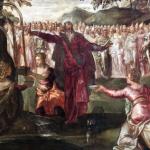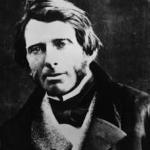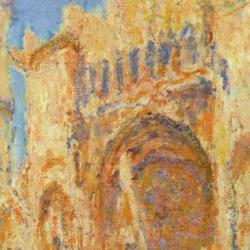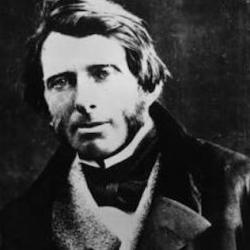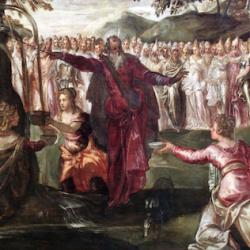Typological forms of thought weren’t confined to sermons and commentaries, but made their way into 19th-century English poetry.
-Some poets put typology to orthodox uses, though here we can see divergent deployments of a similar typology. Elizabeth Barrett Browning wrote a poem, Casa Guidi Windows (1851) about the Browning home in Florence. In one section, she speaks of the priesthood of Christ and the effect it has on the formation of the church:
Through heaven’s gate
The priestly ephod in sole glory swept
When Christ ascended, entered in, and sate . . .
At Deity’s right hand, to mediate
He alone, He for ever. On His breast
The Urim and the Thummim, fed with fire
From the full Godhead, flicker with the unrest
Of human pitiful heartbeats. Come up higher,
All Christians! Levi’s tribe is dispossest.
Browning expresses a typical Protestant/Evangelical view that the order of priesthood that existed in the Old Testament has been replaced by the priesthood of Christ, who shares His priestly standing with all his people. She uses this typology to launch a polemic against the Papacy of Pius IV, Pio Nono:
Why, almost, through this Pius, we believed
The priesthood could be an honest thing, he smiled
So saintly while our corn was being sheaved
For his own granaries! Showing now defiled
His hireling hands, a better help’s achieved
Than if they blessed us shepherd-like and mild.
False doctrine, strangled by his own amen,
Dies in the throat of all this nation. Who
Will speak a pope’s name as they rise again?
What woman or what child will count him true?
False priests, Browning writes, re-crucify Christ. The prelates
take the advantage, agonizing Christ
By rustier nails than those of Cedron’s brook,
I’ the people’s body very cheaply priced, –
And quote high priesthood out of Holy Book,
While buying death-fields with the sacrificed.
Other poets abandon Christianity but still employ typological structures or adhere to a kind of typological imagination. Swinburne provides an example of the first sort of poet. In 1888, he wrote “The Armada” to celebrate the three hundredth anniversary of the English victory over Spain and Papalism. The final stanza includes these lines:
England, queen of the waves whose green inviolate girdle enrings thee round,
Mother fair as the morning, where is now the place of thy foemen found?
Still the sea that salutes us free proclaims them stricken, acclaims thee crowned.
Times may change, and the skies grow strange with signs of treason and fraud and fear:
Foes in union of strange communion may rise against thee from far and near:
Sloth and greed on thy strength may feed as cankers waxing from year to year.
Yet, though treason and fierce unreason should league and lie and defame and smite,
We that know thee, how far below thee the hatred burns of the sons of night,
We that love thee, behold above thee the witness written of life in light.
Life that shines from thee shows forth signs that none may read not but eyeless foes:
Hate, born blind, in his abject mind grows hopeful now but as madness grows:
Love, born wise, with exultant eyes adores thy glory, beholds and glows.
Truth is in thee, and none may win thee to lie, forsaking the face of truth:
Freedom lives by the grace she gives thee, born again from thy deathless youth:
Faith should fail, and the world turn pale, wert thou the prey of the serpent’s tooth.
Greed and fraud, unabashed, unawed, may strive to sting thee at heel in vain:
Craft and fear and mistrust may leer and mourn and murmur and plead and plain:
Thou art thou: and thy sunbright brow is hers that blasted the strength of Spain.
Other poets had made use of the typological/Christological reading of Genesis 3:15. In the Ring and the Book, Robert Browning has his villain, Count Guido Francheschini, speak these words: “God’s decree, / in which I, bowing bruised head, acquiesce” (4.1410-11, quoted in Landow, 105). This seems like an expression of humble piety, but Browning wants us to notice the allusion to Genesis 3: Count Guido hasn’t been bruised on the heel in a Christlike way; he’s bruised on the head, a serpentine wound.
Swinburne makes an even more radical adjustment to the typology. Earlier in the poem, Swinburne warned Pope Sixtus and Philip of Spain that “England’s heel is upon you,” and here he returns to the curse on the serpent in Genesis 3. Faith would fail “wert thou the prey of the serpent’s tooth.” Fortunately, “greed and fraud” are unsuccessful in their attack; they “strive to sting thee at heel in vain” and therefore freedom lives on in the world.
There are two remarkable twists to the typology here. For starters, the Messianic figure here isn’t Jesus but England. England is the one that puts the heel on the head of Spain; England is the one that escapes the attack on its heel. Second, and more subtly, the path of liberation is radically different. Genesis 3, of course, indicates that the seed of the woman would crush the serpent’s head and be wounded in the process. England secures freedom for the world by crushing Spain and avoiding Spain’s sting.
Swinburne was enamored of the Italian nationalist movement, and in several poems used typological categories to represent the struggle of the Italian people against their oppressors. Italy becomes the suffering Christ, and the rulers of Italy are analogous to Christ’s persecutors and killers. Again, the twist on the typology is radical, as he implies in one poem, “A Counsel,” that the “strong Republic” of Italy that is taking shape will outdo Christ Himself in compassion. The counsel is: Avoid making martyrs of their defeated enemies:
When thy foot’s tread hath crushed their crowns and creeds,
Care thou not then to crush the beast that bleeds,
The snake whose belly cleaveth to the sod,
Nor set thine heel on men as on their deeds;
But let the worm Napoleon crawl untrod
Nor grant Mastai the gallows of his God.
In “Before a Crucifix” (1871), Swinburne meditates on an old, decaying roadside crucifix that is the site of prayer and pilgrimage for believers. It turns into a wide-scoped indictment of Christian faith. Like Ivan Karamazov, Swinburne condemns Jesus for not doing enough to correct the evils of the world:
The nineteenth wave of the ages rolls
Now deathward since thy death and birth.
Hast thou fed full men’s starved-out souls?
Hast thou brought freedom upon earth?
Or are there less oppressions done
In this wild world under the sun?
His main target is the Roman Catholic church, which is implicated in the oppression of the Italian people that the nationalist movement is attempting to overcome. The priests have crucified Christ again in his church: “They bind the people’s nail-pierced hands, / They hide the people’s nail-pierced feet; / and what man or what angel known / Shall roll back the sepulchral stone?” (quoted Landow 158). The solution isn’t to return to the church:
Set not thine hand unto their cross.
Give not thy soul up sacrificed.
Change not the gold of faith for dross
Of Christian creeds that spit on Christ.
Let not thy tree of freedom be
Regrafted from that rotting tree.
This dead God here against my face
Hath help for no man; who hath seen
The good works of it, or such grace
As thy grace in it, Nazarene,
As that from thy live lips which ran
For man’s sake, O thou son of man?
Like many critics of Christianity during the nineteenth century, his complaint is centrally that the church hasn’t live up to her own gospel. It’s a post-Christian prophecy against Christianity, but one that borrows heavily from the original prophetic tradition.

